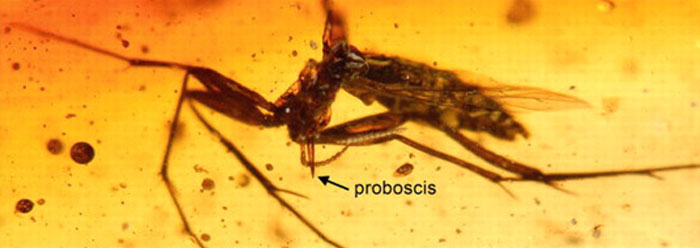Masses of amber, ranging in size "from sand grains to several centimeters"1 in diameter, have been excavated from coal mines in western India. While scientists are excited by the many insect and other species preserved in the amber, the find contains three features that are very difficult to reconcile with evolutionary history. These features, however, fit very well with a biblical view of earth history.
First, the massive amounts of amber are associated with a huge deposit of lignite, which consists of partially coalified plant remains. Such deposits do not form today, so something uniquely catastrophic must have occurred in the past to have resulted in such a large concentration of partially carbonized plant matter. The scale of energy required to form this and similar deposits is certainly consistent with the energy scales implied in the biblical account of the immediate after-effects of the worldwide Flood.2
Second, the researchers found hundreds of insects and other arthropods trapped in the amber, the majority of which appear to be closely related to insects found in Dominican amber, Baltic amber, or even to insects that are still living. But based on the preconception that India was a separate continent for 100 million years before colliding with Asia 50 million years ago, the researchers had expected to find unique species that had evolved in isolation.
The amber deposit, called the Cambay Amber, was "assigned an age of mid- to early- Ypresian (50-52 Ma)," according to the technical paper published in the Proceedings of the National Academy of Sciences.1 Since this corresponds with the evolutionary time assigned to India's merger with Asia, its fossils should reflect the supposed 100 million years of evolutionary change that took place during India's solo journey after breaking away from Gondwana.
Instead, senior author David Grimaldi told The Scientist magazine, "Actually, most of the things that we've studied so far are close relatives of things found in Australia, Northern Europe, Southeast Asia, and tropical South America. We were very struck by that."3 In other words, Grimaldi and his colleagues found a total lack of evolutionary change evidenced in the creatures' bodies.4
Lastly, the remains in the amber, which include "arachnids and crustaceans, and many plant, floral and fungal remains,"5 were so well-preserved that they had "cuticle with ultrastructural preservation,"1 enabling the researchers to see exactly how the creatures looked when they were alive.
The Daily Mail reported that "the amber itself raises questions because the creatures were so well preserved for such a long period of time."6 In fact, the insects and other fossils looked as though they could have been formed last week, which would lead a reasonable observer to question the vast evolutionary age assigned to this particular amber-containing formation.
The study's lead author, Jes Rust from the University of Bonn, stated in a university press release that amber-encased fossils usually decay with time. He said that these insects seemed to have been preserved by "some resin component."7 It wasn't made clear, however, what kind of component could possibly preserve remains for 50 million years.
The idea that these amber insect tissues somehow lasted this long is also refuted by the researchers' description of the amber as being tacky to the touch and easily dissolved. Why is there so little evidence of decay in these insects, which should have occurred even faster in such low-quality, porous amber? And does the tackiness mean that that amber had not had enough time to completely harden?
Evolutionary history is called into question by the extensive size of this amber deposit, the cosmopolitan assemblage of its various insects, and the freshness of the remains. In contrast, biblical history is right in step with the evidence. The creation/Flood model actually predicts that such things would be produced by the massive watery catastrophe and young earth described in Genesis.
References
- Rust, J., et al. 2010. Biogeographic and evolutionary implications of a diverse paleobiota in amber from the early Eocene of India. Proceedings of the National Academy of Sciences. 107 (43): 18360-18365.
- See Thomas, B. Fossilized Gecko Fits Creation Model. ICR News. Posted on icr.org September 8, 2010, accessed October 29, 2010.
- Grant, B. Amber treasures. The Scientist. Posted on the-scientist.com October 28, 2010, accessed October 29, 2010.
- This same problem is not limited to arthropod fossils. See Thomas, B. Did Burrowing Blindsnakes Raft Across the Oceans? ICR News. Posted on icr.org April 22, 2010, accessed October 29, 2010.
- Bhanoo, S. N. Encased in Amber, a Trove of New Species. The New York Times. Posted on nytimes.com October 25, 2010, accessed October 29, 2010.
- Vast collection of insects preserved in amber show India was NOT cut off from the rest of the world 50million [sic] years ago. Daily Mail. Posted on dailymail.co.uk October 26, 2010, accessed October 29, 2010.
- Huge amber deposit discovered in India. University of Bonn press release, October 26, 2010.
Image Credit: Copyright © 2010 by the National Academy of Sciences. Rust et al, Biogeographic and evolutionary implications, PNAS, 107:18360. Adapted for use in accordance with federal copyright (fair use doctrine) law. Usage by ICR does not imply endorsement of copyright holders.
* Mr. Thomas is Science Writer at the Institute for Creation Research.
Article posted on November 5, 2010.

















